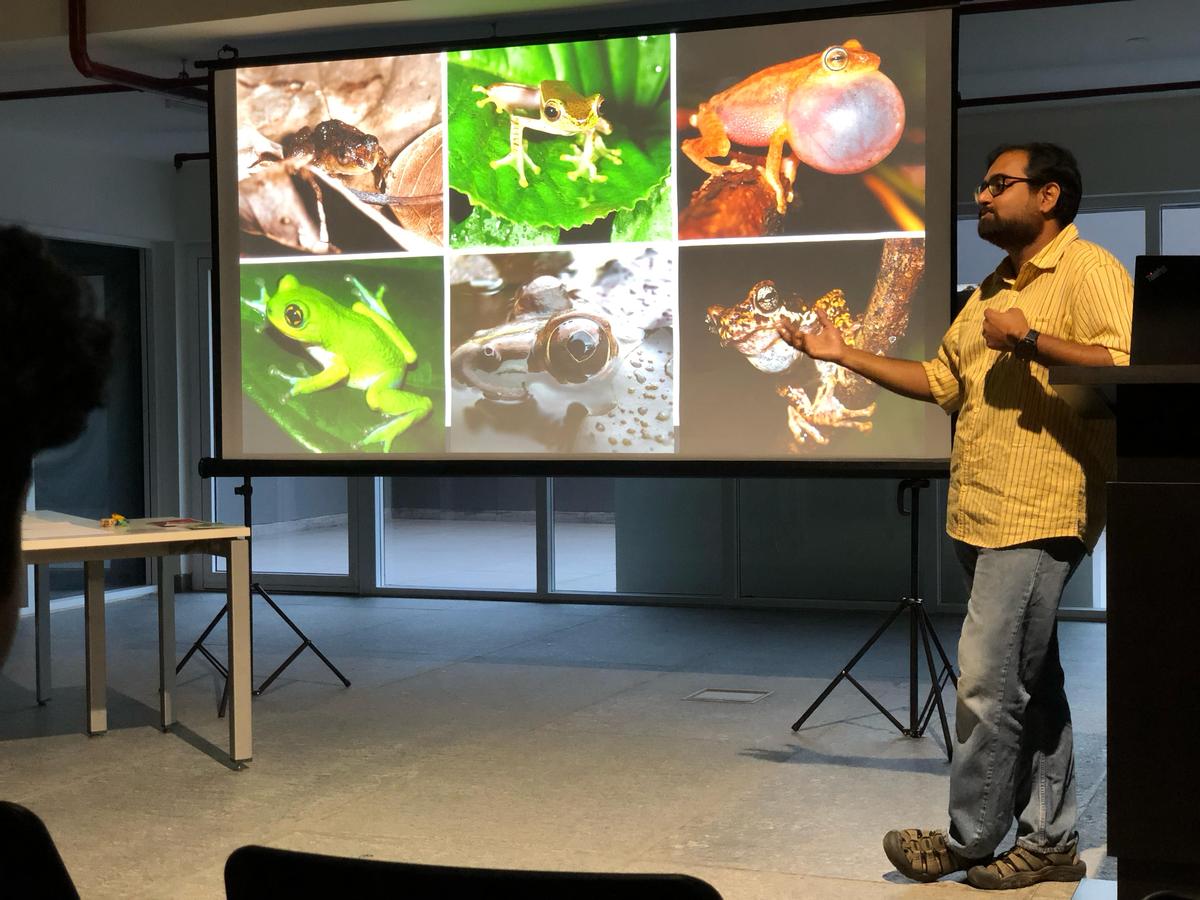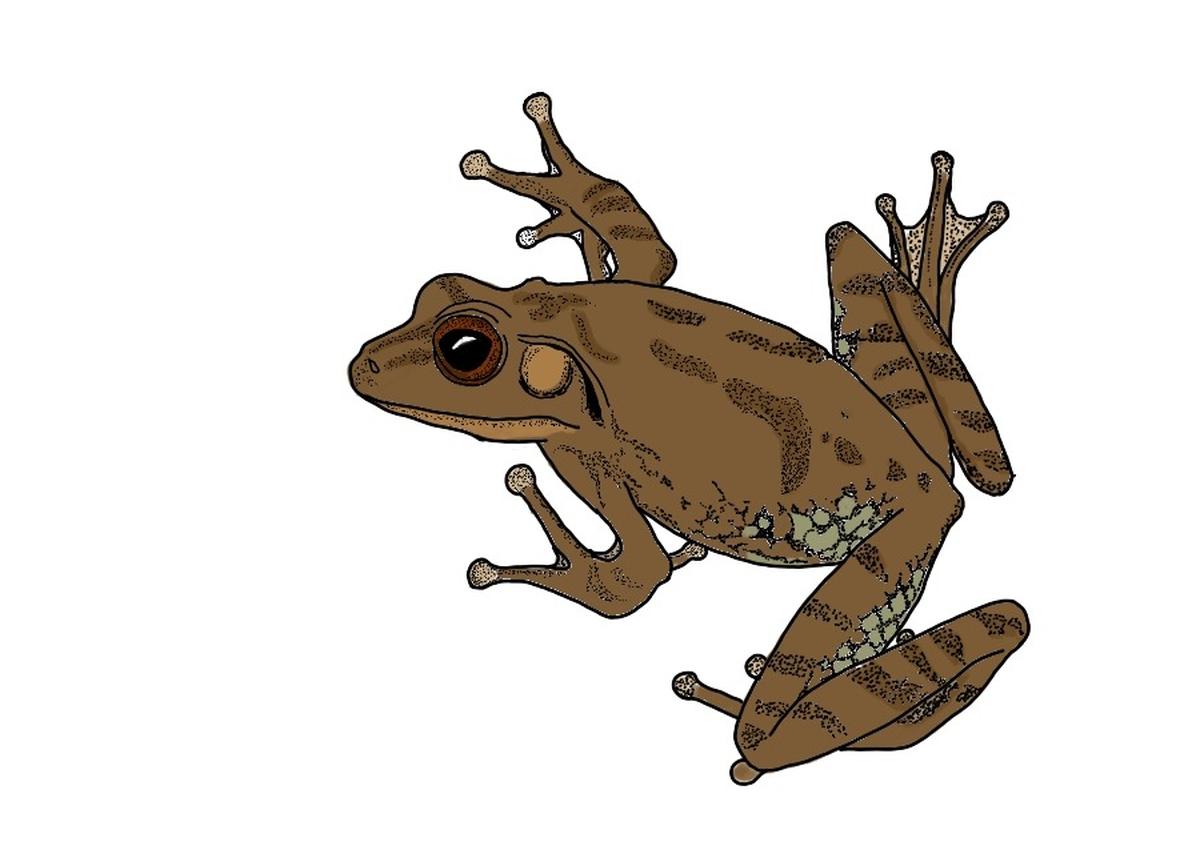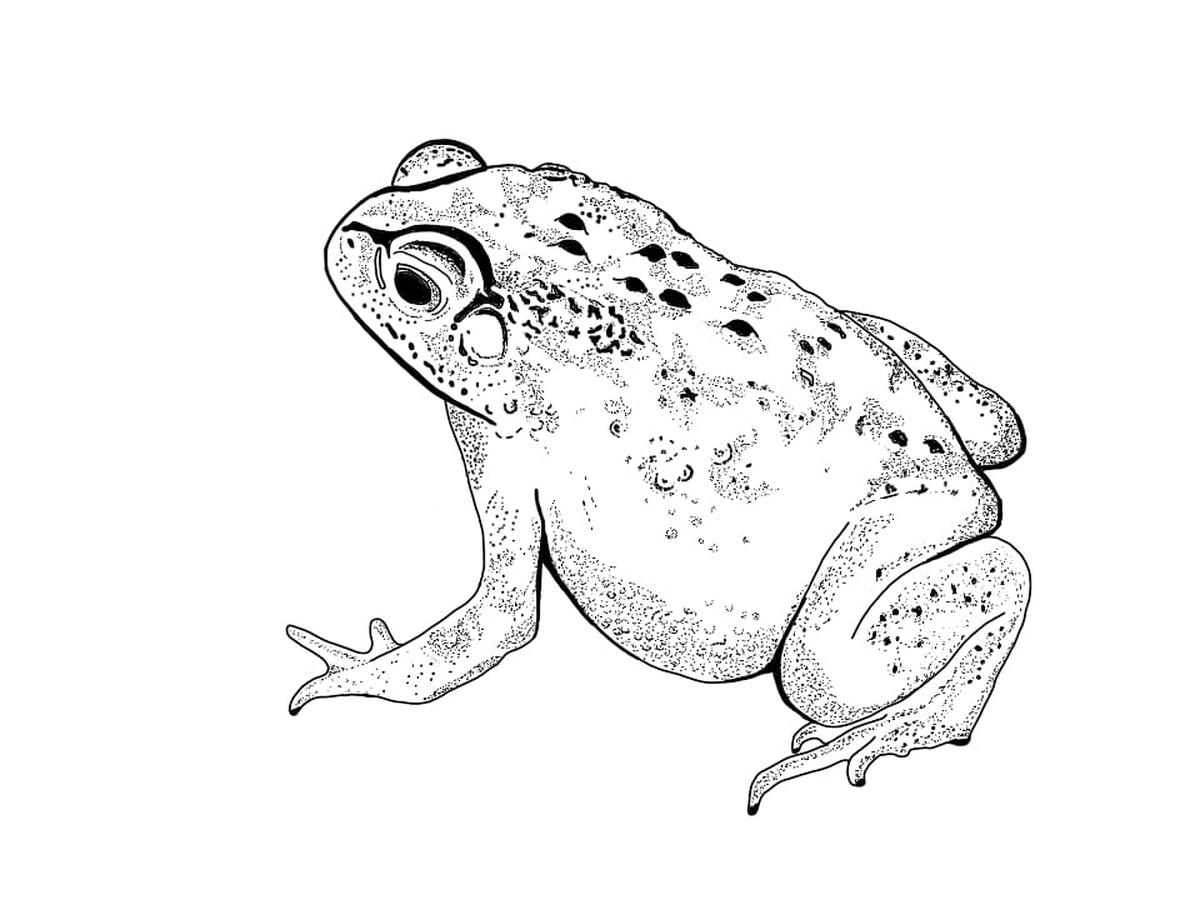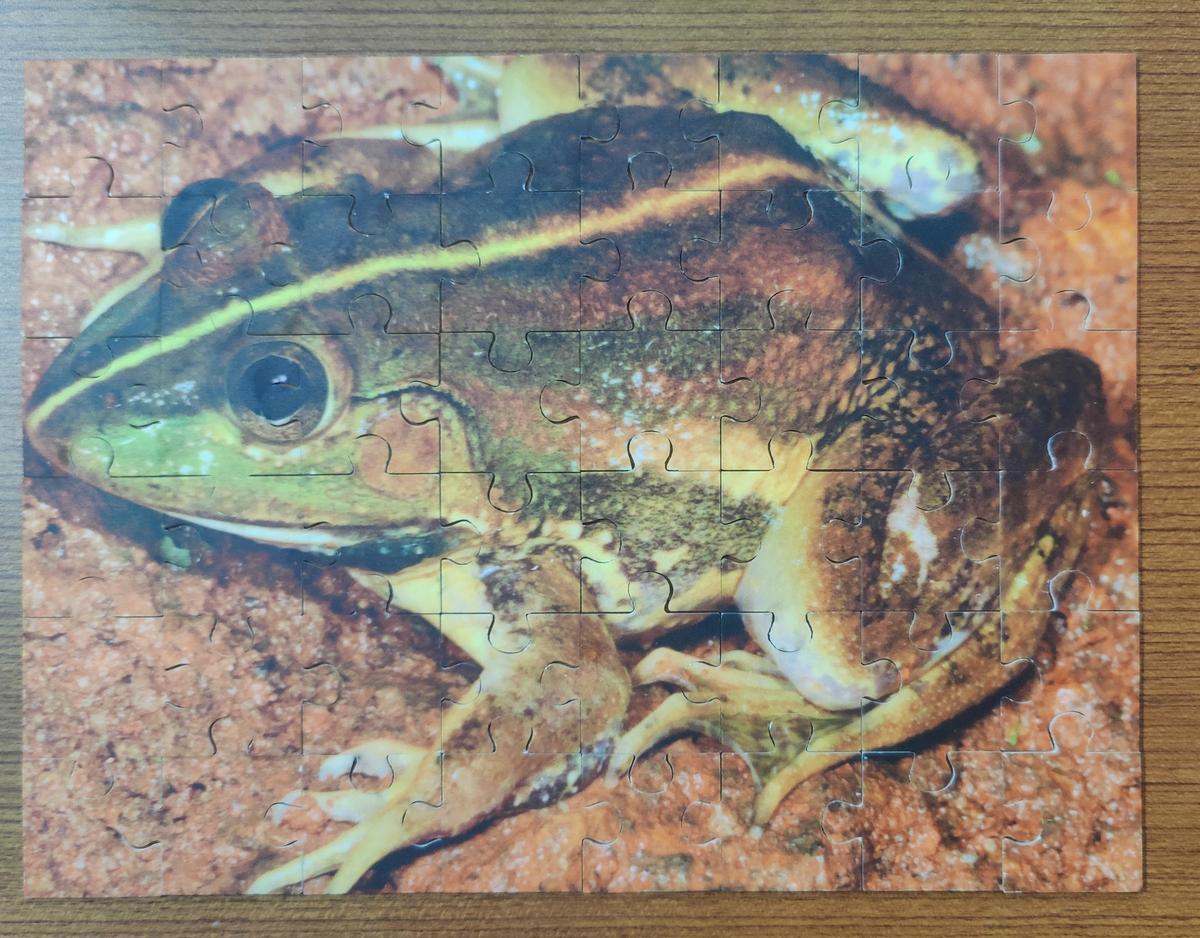At first glance, the large board game laid out in a corner of the Ashoka Trust For Research In Ecology And The Environment (ATREE) terrace in Jakkur, a north Bengaluru suburb, looks like snakes-and-ladders, with numbered gridded squares that go up from 1 to 100. Look closer, however, and you’ll realise that the players take on the role of frogs, and instead of ladders aiding their progress to the finish and snakes hindering it, there are several red and green cells with curious images on them, such as a termite hill, an ochre car, a pool, a garden, stormclouds, a cityscape and a bird, among others.

Seshadri K.S.
| Photo Credit:
SPECIAL ARRANGEMENT
We are looking at the game map of a unique board game called The Hoppy Frog, developed by Seshadri K.S., Vidisha M.K. and Maria Antony, which allows players to experience how a frog negotiates an anthropocentric world. The game, supported by the IndiaBioscience Outreach Grant, is a way of getting people to think more about amphibians and, hopefully, spread a larger conservation message, says Seshadri, a faculty at ATREE. “Games are a useful pedagogical tool… an important aspect of education,” he says. “We can learn more about frogs by playing a game than by listening to one person speak about them.”

The game is a great way to sensitise people to the world of frogs and what they could do to protect them.
| Photo Credit:
SPECIAL ARRANGEMENT
Origin of the boardgame
The impetus for the game came from interacting with children, especially in the natural history workshops focused on frogs conducted in the village of Bisle near Sakleshpur in the foothills of Western Ghats by Bisle Frogwatch, a citizen-led initiative. “It is a two-and-a-half-day camp about appreciating frogs,” says Vidisha, a programme officer at the Dakshin Foundation in Bengaluru.
These workshops, which introduce participants to frogs and teach them skills to identify, document, and study their behaviour, have become more popular over the years. However, it was also felt that engaging participants in more immersive ways could be used since lecture-centred knowledge-sharing in a typical classroom format could get monotonous. So, they thought of having a cool game where people were up on their feet and actively learning about what it is to be a frog in a human-dominated world.

The Hoppy Frog, which was launched in 2024.
| Photo Credit:
SPECIAL ARRANGEMENT
The game, which is now a vital part of the learning experience at Bisle Frogwatch and other workshops, is a great way to sensitise people to the world of frogs and what they could do to protect them since it offers insights into what is good for the frog and what we can do as an individual as well, elaborates Vidisha.
The Hoppy Frog, which was launched in 2024, has had over 800 people playing it so far via workshops conducted in the city and outside of it, including at Science Gallery, Bengaluru, the India Institute of Science’s annual Open Day and the Bisle Frog Walk. There is also an online version of the game developed by the ATREE communications team that is accessible to all on the trust’s website. Since the game has been created under a Creative Commons license, the creators plan to make available the PDF files for the board game and the cards in the public domain. “This way, people can modify content such as language and use it for their own needs,” says Seshadri.

Threats and challenges
At ATREE, we divide ourselves into two teams, roll two large dice and begin playing the game, the goal of which is to reach the pond where “the frog can live happily ever after,” says Seshadri. Instead of counters, we use origami frogs, which, according to him, is a way for players to understand frog morphology. “At workshops, we make players make their frogs so that they know the different parts of the animal’s body,” he explains.
Additionally, it helps them discover that frogs “have different features on their bodies: spots, stripes, mottling or no marking at all,” says Seshadri, who uses this exercise to teach players how frogs are pooled into various taxonomic groups, such as genera, species and families.
Players need an even number to start, and once they get it, they begin moving on the board where light-coloured spaces are interspersed with bright red and green ones. The number on the coloured squares is matched by a corresponding card, also in green and red, which explains how a particular set of circumstances impacts your frog.
For instance, when the origami frog lands on a green square, which indicates an unkempt garden, represented by a patch of flowers and a signboard saying garden on it, we get to move ahead three additional steps since a space like this full of insects for a frog to eat, helping it to get energised. On the other hand, when the frog lands on a red square with a hairy house centipede on it, it ends up having to go all the way to the start since large centipedes are known to prey on frogs.
While some factors depicted on the red squares, such as predators, road kill, or a heat shock, could lead to population decline, it probably won’t cause the species to become extinct. In contrast, some threats like chytrid fungus, a highly contagious pathogen that causes a fatal skin disease in frogs worldwide, could. “Those are some of the nuances that we hope people will pick up or, at least, start thinking about as they play,” says Vidisha.

Why frogs matter
Amphibians, the class to which frogs belong, are among the most threatened animal groups in the world, with nearly 40% of most amphibian species being globally threatened, according to the second Global Amphibian Assessment published in Nature in October 2023. The study, which evaluated over 8000 species for the International Union for Conservation of Nature Red List of Threatened Species, states that amphibians are declining rapidly, with disease and habitat loss being primarily responsible for their decline. “Ongoing and projected climate change effects are now of increasing concern,” says the paper.
The current conservation narrative, primarily skewed towards preserving large carnivores like lions and tigers, often neglects smaller animals like frogs. And yet, “pound for pound, in terms of biomass, if you put all the frogs together, they probably have a greater biomass than all your large charismatic animals”, points out Seshadri.

Amphibians also play an important role in pest control since they prey on insects and are often used in medical research since their skin produces chemicals called antimicrobial peptides (AMPs), which, like antibiotics, help the animal fight infection.
| Photo Credit:
SPECIAL ARRANGEMENT
It is also essential to halt the decline in amphibians because of the larger ecological role that they play. They are found everywhere, says Seshadri, “except for the snow-capped mountains and the poles of the earth.” He thinks of frogs “as a canary in a gold mine”, a phrase that comes from the old practice of miners taking these small songbirds into mines to indicate the quality of air. Indicator species, like frogs, which are deeply sensitive to environmental changes, play a critical role in ecosystem function, he says, adding that the presence of a diverse frog population in a forest, for instance, means that it is intact and healthy.
Amphibians also play an important role in pest control since they prey on insects and are often used in medical research since their skin produces chemicals called antimicrobial peptides (AMPs), which, like antibiotics, help the animal fight infection. “The next big medical discovery can come from a frog,” says Seshadri. Additionally, they are incredibly diverse, often very colourful, and display many complex behaviours, including parental care, which “we think is unique to humans or higher-order vertebrates,” he says. “But frogs the size of my thumb can also care for their offspring.”
Even though India has an incredible diversity of amphibians – over 400 species – we don’t appreciate them enough, suggests Seshadri. “I think we ought to have more local resources to get people to appreciate nature and push them towards conservation,” he says. In that sense, the board game is about creating a resource that can help reach out to people and catalyse nuanced conversations around frog conservation. “Once you get people to think on those lines, you can nudge them to do something,” he believes. “You might not save forests or prevent extinction, but you might talk to five other people about frogs and help spread the conservation message.”
To know more, log into https://www.atree.org/resources/
Published – January 17, 2025 09:00 am IST







